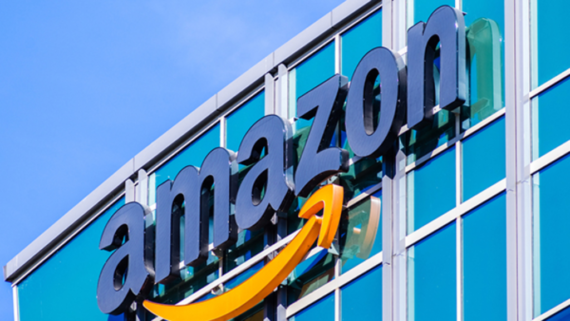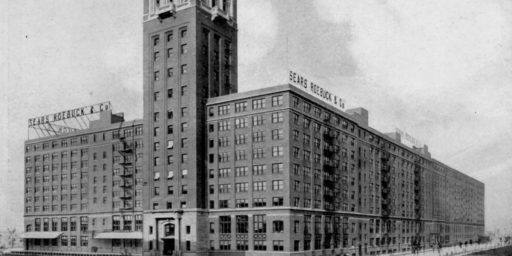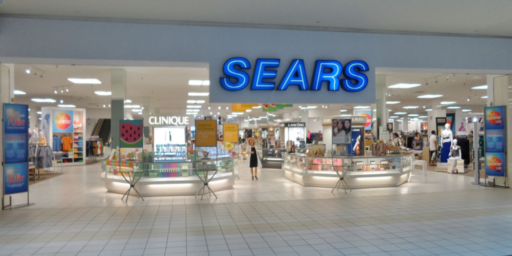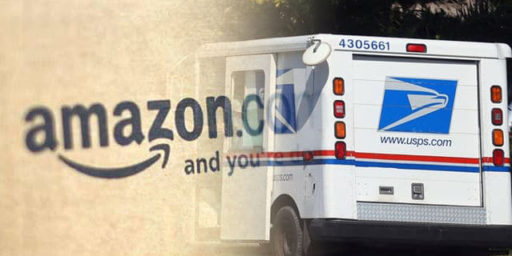Amazon Eying Empty Sears, JC Penney Stores
The online behemoth is consolidating its market position during the pandemic.

As shopping mall anchor stores go out of business, Amazon is looking to fill the vacuum by taking over their spaces.
Wall Street Journal (“Amazon and Mall Operator Look at Turning Sears, J.C. Penney Stores Into Fulfillment Centers“):
The largest mall owner in the U.S. has been in talks with Amazon.com Inc., the company many retailers denounce as the mall industry’s biggest disrupter, to take over space left by ailing department stores.
Simon Property Group Inc. has been exploring with Amazon the possibility of turning some of the property owner’s anchor department stores into Amazon distribution hubs, according to people familiar with the matter. Amazon typically uses these warehouses to store everything from books and sweaters to kitchenware and electronics until delivery to local customers.
The talks have focused on converting stores formerly or currently occupied by J.C. Penney Co. Inc. and Sears Holdings Corp., these people said. The department-store chains have both filed for chapter 11 bankruptcy protection and as part of their plans have been closing dozens of stores across the country. Simon malls have 63 Penney and 11 Sears stores, according to its most recent public filing in May.
Sears (established 1893) and Penney’s (1902) are venerable staples of American retail. We shopped at both regularly when I was a kid, but they’ve been slowly losing relevance most of my adult lifetime. They’re going to go the way of Montgomery Ward, which started even earlier, and went out of business in its original form in 2001.
The talks reflect the intersection of two trends that predate the pandemic but have been accelerated by it: the decline of malls and the boom in e-commerce.
Malls were struggling for years, as more customers stayed home to shop online. The spread of the coronavirus, which forced malls to temporarily close and limited their crowds even after reopening, has worsened the situation. Amazon, meanwhile, was able to navigate new logistical challenges during Covid-19 and recently reported its greatest quarter ever.
For Amazon, a deal with Simon would be consistent with its efforts to add more distribution hubs near residential areas to speed up the crucial last mile of delivery.
But for Simon, any deal to surrender prime space to Amazon would signal a break from a longtime business model for malls: reliance on a large department store to draw foot traffic to neighboring shops and restaurants.
That model has broken down in recent years, as many department stores are now fighting for their lives. Lord & Taylor also filed for bankruptcy early this month, while Neiman Marcus Group Ltd. filed in May. Nordstrom Inc. closed 16 stores in recent months.
It’s been a long time since the business model of shopping malls, let alone huge department stores, made much sense. Malls are massively expensive to build, become dingy and outdated rather quickly, and are cumbersome to navigate. The anchor stores are mostly undifferentiated and have long played the absurd game of charging way to much for items so that they could offer massive “markdowns” during near-constant “sales events.”
The very high-end stores, like Neiman Marcus and Nordstrom, at least offered luxury and differentiation for those who could afford it. But even they largely poorly-made junk imported from China.
Still, presuming the deal goes through, Amazon’s influx would be a pyrrhic victory.
Simon’s other tenants might not celebrate a deal with Amazon. Many blame the giant online retailer for severely disrupting their business. Its presence as a new neighbor would likely do little to pacify them, especially if Amazon’s new distribution capabilities in well-located Simon malls help make it even more competitive by helping speed up its delivery times.
Amazon fulfillment centers wouldn’t draw much additional foot traffic to the mall, though some employees could eat and shop at the mall. That is why landlords have preferred to replace department stores with other retailers, gyms, theaters or entertainment operators. Yet many of these tenants are struggling to survive during the pandemic and aren’t in expansion mode.
Simon would likely rent the space at a considerable discount to what it could charge another retailer. Warehouse rents are typically less than $10 a square foot, while restaurant rents can be multiples of that. Depending on when the leases were signed and their locations, department-store rents can be as low as $4 a square foot or as high as $19 a square foot.
The mall only makes sense if it’s a destination unto itself. If you’re shopping for a pair of jeans or or some running shoes, it’s just so much easier to buy it from Amazon or another online outlet. The mall is only attractive if you’re trying to while away a few hours, seeing a movie or having a meal around some shopping. But, of course, that’s either not allowed or not advisable right now.






On the rare occasions I shop for anything but food and drink, I can buy a pair of jeans in ten minutes at the shop 2 miles away from my house. Explain to me why Amazon is quicker than that. Or more secure, given that I don’t have to worry about porch pirates for anything I buy in person.
I don’t object at all to online shopping: I just think it’s not always the ideal answer.
Small world – I said this just last night as I drove my mother home from shopping past a dying mall. No anchor stores left, barely a food court and maybe 15 small businesses left inside – less if you leave out the kisoks. It’s in a prime location since everything built up around it; good traffic flow, easy access to highways, plenty of parking, a large building with multiple service/truck entrances you might need to knock some walls down but otherwise serviceable. You could easily add a couple dozen trucks per day and nobody would notice since there’s already a ton of trucks coming and going from the toll barrier nearby.
I don’t really think it would be a shopping stop, per se but it would be nice to have the option to go get your package. If it would shave a day or two off a long delivery time (*cough* Trump slowing mail down *cough*), I wouldn’t mind working it into my routine. Rather, I think malls would be fine warehouses albeit smaller then Amazon would want. Really, how many businesses are left in a mall that can’t relocate, especially if offered a little incentive? Those that survive COVID might welcome the chance to get out of a bad floor space deal and get a better one in a nearby strip mall with better promote-ability. Offer them a 5 year deal of cheap or free shipping for Amazon to get them out and I think you’ll see a lot of willing takers. It adds tax value back by making malls money makers for the town again.
Mall developers need to understand their business model is dying. Partitioning off half the property for warehouse space and half for retail is better then having it most of it empty. By the time they’re begging for this kind of deal to say afloat, Amazon will have built their own warehouse to their own specs and not need them anymore.
@CSK: For me, it’s more of a “will it be in stock?” problem. For example, because of a lower-leg issue, I buy a particular model of New Balance running shoe. Few stores keep it in stock. The ones that do tend to have it in size 11 or size 6, but not 9.5. Will the store have the right size jeans in the brand I prefer in stock? Any of the retail outlets can get them “from the warehouse”, but it takes much longer for them to do it than for me to order it up from Amazon’s warehouse. Amazon gets them to me in two days — well, more often four days right now — regardless of whether the warehouse that has my size is here in Denver or in New Jersey.
A better answer for the dying shopping mall is urban renewal for the 21st century creating edge cities of mixed use development. In many metro areas the mall is already has transportation access, both roads and public transit (buses).
@CSK:
A lot of people don’t live that close to shops. Amazon offers convenience and amazing price transparency. I’ve ordered countless items from them over the last 20-plus years. I don’t think I’ve ever had a package stolen.
@Michael Cain:
Thanks; cases such as yours would be the very ones in which online shopping would prove most efficient. I’m amused by how some people seem to approach it: one of my neighbors ordered one of those fresh meal kits, the kind they rush to you and you’re supposed to prepare right away–and then let it sit in the lobby of our building for at least a week. What was the point, I wondered. Just to mail-order something?
The mall near me has a Sears, Dillards, etc. Haven’t been to it in 10 years. Indoor malls are obsolete. The thriving shopping center in our city is the Town Square concept which basically seems like the indoor mall without the roof and with pedestrian walkways.
It is funny that Amazon may want to use the Sears footprint. After all, our Sears parking lot is filled with Amazon Prime delivery trucks. May as well use the inside also.
@James Joyner:
I think online shopping is great for people who live in more rural areas, and clearly you probably do. But I live in a place where shopping opportunities abound, and it really does confound me that people will wait several days for Amazon to send them something like printer paper when they could pick up the exact same thing at a shop 2 miles away in a brief trip.
I like Amazon. I have a back room full of cardboard from Amazon. But I visited one of Amazon’s bricks and mortar stores in Glendale, in an upscale mall, and it was a grim, disheartening experience. All the charm of a Costco with none of the selection.
My big problem with online shopping, is that browsing is more time consuming and far less satisfying, especially as concerns books and clothes. At a store, you’re more likely to stumble into something you didn’t even suspect existed.
@Michael Reynolds: Back when I worked for Amazon in 2005 or so, they had an employees-only store that sold one of every item on the website — the one that was taken out of the box and photographed. And every item had a price tag with dates and declining prices. It was like a yard sale, except in an otherwise unused section of a hybrid office/local-distribution-center.
Fancy cookware would sit next to a half-painted paint-by-numbers, next to a lawn ornament, next to a CD player. Once I bought a 6 foot tall inflatable chicken-duck body-horror-thing breaking out of an easter egg — it had duck feet on its arms and a rooster’s red crest. It then lived in a conference room and was quietly terrifying (every once in a while you would notice something else wrong with it, like that it had teeth). Best dollar I ever spent.
@Kathy:
This. You’re absolutely right. Nothing beats a good bookstore.
In the little town that I live in, the mall is all but officially dead. Built in the late 70s (I think, I lived in the big city in those days and don’t fully remember), the mall was most noteworthy for having destroyed the downtown retail district of neighboring Longview, where the Penney’s store and some other significant retailers all left across the river to the mall.
As time has progressed, the mall has also gone the way of the dodo. The Sears store closed to become a Regal Cineplex (with the outdoors/garden/appliance store moving back to Longview, ironically enough), The Bon Marche transitioned to a Macys in the Allied Stores buyout, and then to vacancy. The Emporium store transitioned from an outdoors discounter to a shoe discounter, the Penneys was the smallest of the anchors and holds its own for the moment. The wing next to Penneys transitioned from small shops to one large scale storefront housing first an all-you-can-eat buffet and then the largest Planet Fitness in the region (according to the manager) in a slight show of irony. Across the hallway, 3 or 4 shops were gutted for the regional library to move in. The balance of the mall is composed of shops that mostly constitute hobbies/places to be busy for their retired and more solvent that most owners. The supermarket went through 2 hands (disastrous expansions by regional family owned grocery chains) before settling in as a Safeway.
The other store on the property is a free standing Target store, which has always struggled but has recently been remodeled. One of my neighbors works there and explained to me that the store has taken on a new life–as a regional distribution/fulfillment hub for Target Online.
@Just nutha ignint cracker:
Ah yes, the regional grocery conglom by the REIT buy out artists who were convinced they were the smartest people in the room. What fascinates me in retirement retail is threefold; (1) the people who buy on line and then return it to the store when they don’t like it, (2) the people who don’t shop there but walk through the store to see the item they’re going to buy from Amazon, and (3) the REIT ubermasters who’d rather leave space empty than take a discount on the overpriced rent, because they get a tax break. OTOH, that regional empty mall is a decent place to go for a walk when the weather’s nasty. Plus I can check out a library book there.
@Kathy: Yeah, I miss having a nearby bookstore for books for entertainment. I started buying technical books from Amazon when it was barely past the “Bezos in a garage” stage. One, it was easier to order a specific title that even the best of the local bookstores was unlikely to have on the shelf. And two, Amazon got a very useful review system running early on. Knowledgeable people made intelligent comments about the good points and bad points of the books. Eg, I was often looking for things that would make a good text for a graduate class, or for an experienced professional. There’s a ton of books that claim to be aimed at that level. Most of them are somewhere between bad and dreadful. The publishers’ reviews of those are worthless.
No kidding. Every textbook from every publisher is touted as the best book of its kind ever published. In reality most textbooks are probably good matches to some sets of students and teachers, but if the text isn’t a match at both user sets, it’s just a couple of hundred dollars worth of recyclable paper.
@CSK: I live in the DC exurbs of Fairfax County but intentionally a bit remotely on five acres. I’m pretty close to pretty much anything I want but there’s a lot of traffic so it’s not that fast. If I absolutely need printer paper today, I’ll make a trip to Costco or Walmart. But I can get it cheaper from Amazon, quite possibly within 24 hours. If I order in the morning, it’s often here by late afternoon.
@Kathy: @Michael Cain: @Michael Cain: There are times when the serendipity of in-person shipping is better. But Amazon got its start as a bookstore and can be pretty great at presenting recommendations. And I can find used copies of 80% of the books I want for a song.
@James Joyner:
When you want a specific title, the online search function is superior. It works even if you have a partial title, or just the author’s name, or even part of the name.
I’m ambivalent about recommendations.
For items other than books or movies, search is only so useful. Often the descriptions are wrong, or may use terms different than those you use. In time you learn to use several search terms.